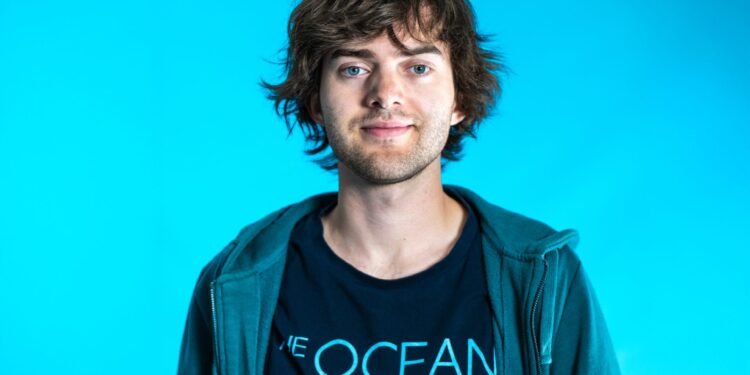What if a teenager could solve one of the world’s biggest environmental problems? This question sparked the journey of a remarkable dutch inventor who dared to challenge ocean pollution.
Boyan Slat was born in July 1994 and founded The Ocean Cleanup at just 18 years old. Today, he serves as ceo ocean cleanup of this innovative non-profit organization.
The organization’s Rotterdam headquarters now employs over 120 people from 30+ countries. Despite his young age, this inventor has built a serious environmental technology operation.
His Croatian heritage through his father adds to the diverse background that shaped his mission. This introduction explores how early experiences fueled his ocean conservation ambitions.
Key Takeaways
- Founded The Ocean Cleanup organization at just 18 years old
- Leads a team of over 120 international employees
- Headquarters based in Rotterdam, Netherlands
- Of Dutch and Croatian descent
- Pioneered innovative ocean plastic cleanup technology
- Represents a new generation of environmental innovators
- Demonstrates how young inventors can tackle global problems
Introduction to Boyan Slat and The Ocean Cleanup
At just 16 years old, a Dutch student encountered more plastic than marine life during a Mediterranean dive. This disturbing experience would spark an environmental revolution.
Early Life and Education
The young innovator pursued aerospace engineering at Delft University. This technical background provided crucial skills for addressing complex environmental challenges.
University studies focused on engineering principles that would later inform cleanup technology development. The academic environment nurtured creative problem-solving approaches.
The Founding Vision
The diving experience directly inspired a high school science project focused on plastic pollution. This project developed into the initial idea for passive collection systems using natural ocean currents.
A 2012 TEDxDelft presentation first shared this innovative ocean cleanup concept with the public. The video went viral in early 2013, generating unprecedented global attention.
This viral momentum enabled the founding of The Ocean Cleanup organization despite limited initial resources. The team started with just €300 but quickly grew through volunteer support and crowdfunding success.
The organization’s mission addressed the growing crisis of ocean plastic pollution through technological innovation. This commitment required leaving university studies to focus entirely on environmental solutions.
The Global Ocean Plastic Pollution Crisis
Imagine a floating island of trash so massive it dwarfs entire European nations. This is the reality facing our world oceans today.
Scale of the Problem: Pacific Garbage Patch
The Great Pacific Garbage Patch spans an area larger than France, Germany and Spain combined. This floating mass contains approximately 79,000 tons of plastic debris.
Scientific research reveals this estimate is 4-16 times higher than previous calculations. Nearly half (46%) consists of abandoned fishing nets known as ghost nets.
These discarded nets continue trapping marine life long after being lost. The patch represents just one visible symptom of broader world oceans plastic pollution.
Environmental Impact on Marine Ecosystems
Marine animals face catastrophic consequences from plastic contamination. In the most polluted zones, plastic outnumbers marine life by 180 to 1.
Sea turtles in affected areas consume plastic comprising up to 74% of their diet. Many species regularly ingest plastic debris mistaken for food.
Toxic chemicals attached to plastic enter the marine food chain. These pollutants eventually reach humans through seafood consumption.
Conventional cleanup methods would require an estimated 80,000 years. This timescale highlights the urgent need for innovative solutions to address oceans plastic pollution.
From High School Project to TEDx Inspiration
A single moment underwater can change a person’s entire life path. For one young innovator, this moment came during a Mediterranean dive that revealed a disturbing truth about our oceans.
The Greece Diving Experience That Changed Everything
In 2011, a teenage diver encountered more plastic bags than fish during a trip to Greece. This shocking discovery made him question why nobody was cleaning up this mess.
The experience became a turning point that would define his future work. He realized traditional cleanup methods were insufficient for the scale of ocean pollution.
Developing the Initial Concept
This personal experience directly inspired his high school science project on ocean plastic solutions. His background in aerospace engineering provided unique problem-solving skills.
He developed the radical idea of using ocean currents for passive cleanup systems. Instead of chasing plastic, the technology would let currents bring plastic to collection points.
His 2012 TEDx presentation introduced this innovative approach to the public. The TEDx talk went viral in 2013, spreading through news blogs and social media.
This viral attention enabled a successful crowdfunding campaign that raised $90,000. The funds supported a comprehensive feasibility study to test his concept.
The year-long study examined the technical and financial feasibility of his approach. Despite early scientific skepticism, he persisted with his vision.
In June 2014, the team published a 528-page report detailing the project’s potential. This document became the foundation for all future development work.
Developing the Ocean Cleanup Technology
Turning a bold vision into working hardware required groundbreaking engineering. The team faced immense technical hurdles while creating a system that could withstand harsh ocean conditions.
Feasibility Study and Scientific Research
Before building anything, researchers conducted extensive studies. They needed to prove the concept could work in real ocean environments.
The team analyzed plastic movement patterns and current behaviors. This research confirmed that natural ocean currents could power the cleanup process.
Scientists tested materials that could survive saltwater corrosion and extreme weather. They determined that a durable plastic tube with nylon screening offered the best solution.
Technical Challenges and Iterations
The first deployment, System 001, revealed unexpected problems. The device struggled to retain captured plastic and suffered structural damage.
Engineers completely redesigned the system for version 001/B. They created a moving anchor that traveled slower than the currents.
This simple but brilliant innovation allowed the system to scoop plastic effectively. The improved design successfully captured debris as small as 1 centimeter.
The technology operates completely autonomously without external energy sources. It represents a cost-effective solution compared to traditional cleanup methods.
This iterative approach demonstrates how innovation often requires multiple attempts. Each failure provided valuable data that led to better solutions.
Implementation of Cleanup Systems
Testing innovative technology in the real ocean presents unique challenges. The journey from concept to working systems required multiple iterations and improvements.
Each deployment provided valuable data that shaped future designs. This process demonstrates how environmental innovation often works through trial and error.
System 001 and 001/B: Early Deployments
The first ocean cleanup system faced unexpected difficulties in 2018. It struggled to retain captured plastic and experienced structural issues.
Engineers completely redesigned the approach for System 001/B. They created a moving anchor that traveled slower than ocean currents.
This simple but brilliant innovation allowed effective plastic capture. The improved design successfully returned 60 bags of garbage from the Pacific.
This early success proved the concept could work in real conditions. It marked a crucial milestone for the entire cleanup organization.
System 002: Proof of Technology Success
System 002 represented a major technological leap forward. This enhanced design demonstrated unprecedented cleanup capabilities.
In July 2021, the system gathered 9,000 kg of ocean trash. This massive haul equivalent to 20,000 pounds proved the technology’s potential.
The success validated years of research and development work. It showed that large-scale ocean cleanup was finally possible.
This breakthrough attracted increased support from environmental groups. It positioned the organization as a leader in ocean conservation technology.
The Interceptor: Preventing River Plastic Flow
While cleaning ocean garbage patches remains crucial, prevention offers equal importance. The organization developed a complementary river cleanup system.
Scientific research identified 1,000 rivers responsible for 80% of ocean plastic. This data-driven approach guided strategic deployment decisions.
The Interceptor operates entirely on solar power for sustainability. It uses conveyor belts to extract plastic from river currents continuously.
Current deployments include Indonesia, Malaysia, and Dominican Republic. Additional systems operate in Vietnam with plans for Thailand and Los Angeles.
This dual approach addresses both existing pollution and future prevention. It represents comprehensive environmental business thinking from a young entrepreneur.
The systems work autonomously, requiring minimal human intervention. They represent scalable solutions to a global environmental challenge.
Achievements and Global Recognition
Through tireless dedication and innovative thinking, The Ocean Cleanup has transformed from a bold idea into a globally recognized environmental force. The organization’s journey demonstrates how vision combined with action can create meaningful change.
Environmental Impact and Progress Metrics
The cleanup systems have achieved remarkable results in removing plastic pollution. Recent operations have successfully extracted thousands of tons of debris from our oceans.
These efforts represent significant progress toward the goal to rid world oceans of plastic waste. Each deployment brings us closer to cleaner marine environments.
The initial crowdfunding campaign set records with $2.2 million raised. This came from 38,000 supporters across 160 countries worldwide.
Subsequent funding rounds attracted major donors including Silicon Valley entrepreneurs. This financial support enabled scaling operations to address the global plastic crisis.
Awards and International Honors
The groundbreaking work has received prestigious recognition from international organizations. In 2014, the United Nations Environment Programme awarded its Champions of the Earth honor.
Norwegian royalty presented the Young Entrepreneur Award in 2015. This recognition highlighted the innovative approach to environmental challenges.
Forbes included the founder in their 30 Under 30 list for European Science in 2016. The Thiel Fellowship provided $100,000 to support continued innovation.
Reader’s Digest named him European of the Year in 2017. That same year, Elsevier magazine awarded Dutchman of the Year honors.
2018 brought both the Leonardo da Vinci International Art Award and European Entrepreneur of the Year. The Project Management Institute’s Future 50 Leaders award followed in 2020.
These accolades span multiple years of consistent achievement and global impact. They reflect growing international support for ocean conservation efforts.
Conclusion: The Future of Ocean Conservation
Our oceans’ health depends on innovative solutions tackling plastic pollution. The Ocean Cleanup continues its vital mission with active operations in the Great Pacific Garbage Patch and expanding river deployments.
Interceptor systems now operate in key rivers worldwide, preventing trash from reaching the ocean. These technologies represent significant progress in environmental conservation.
The organization’s CEO remains deeply involved in strategy and scientific research. His work has produced multiple patents and scientific publications advancing cleanup technology.
Future developments promise even more efficient systems for removing ocean plastic. This ongoing innovation offers hope for significantly reducing global pollution.
Young inventors everywhere can draw inspiration from this environmental success story. Their fresh perspectives may develop the next breakthrough in ocean conservation.
FAQ
What is the Great Pacific Garbage Patch?
The Great Pacific Garbage Patch is a massive area in the ocean where plastic pollution has collected due to ocean currents. It is the largest of five such zones and contains high concentrations of debris, posing a severe threat to marine life.
How does The Ocean Cleanup technology work?
The technology uses a long, U-shaped barrier that moves with natural ocean currents to concentrate plastic. The system then collects the debris for removal and recycling, offering a scalable solution to reduce ocean plastic pollution.
What inspired Boyan Slat to start The Ocean Cleanup?
While diving in Greece during high school, he saw more plastic than fish. This experience motivated him to develop an innovative solution, which he later presented in a TEDx talk, leading to the founding of the organization.
What is the Interceptor and how does it help?
The Interceptor is a solar-powered device designed to capture plastic in rivers before it reaches the ocean. It is a key part of the strategy to address pollution at its source and prevent new debris from entering marine environments.
Has The Ocean Cleanup been successful so far?
Yes. System 002, known as “Jenny,” successfully removed tens of thousands of kilograms of plastic from the Great Pacific Garbage Patch. The project continues to scale up operations and refine its technology for greater impact.
What were some major challenges in developing the cleanup systems?
Early systems faced technical issues, such as material fatigue and difficulty retaining collected plastic. Through rigorous feasibility studies and engineering iterations, the team overcame these obstacles to create more effective and durable designs.





